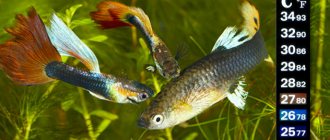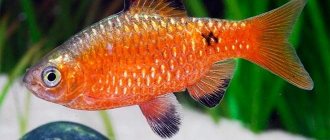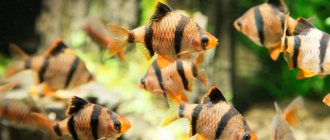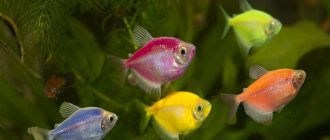Dimensions of small reservoirs and their purpose
Even the smallest fish aquarium should be equipped with the necessary devices:
- filter;
- aerator;
- heater;
- lighting.
The advantages of small tanks include the following:
- compactness;
- easy care;
- convenient transportation.
However, miniature reservoirs also have disadvantages. First of all, due to the small volumes, it is impossible to contain many inhabitants in the vessel. Secondly, the water in small aquariums gets dirty faster, so you will have to carefully monitor cleanliness and order. In tanks with a large volume, water changes are not as noticeable as in tiny ones, where any changes in environmental parameters lead to stress for the fish.
Small aquariums are divided into four types:
- Up to 5 l – suitable for interior decoration and planting. For example, only one tiny phenotype can be placed in a 2-liter aquarium, but experts recommend keeping such an aquarium without fish, because living in a cramped space makes pets feel discomfort. In addition, it is impossible to install equipment in such miniature reservoirs, so an aquarium without fish would be a humane solution.
- From 5 liters to 10 liters - a tank with such a displacement is also not entirely suitable for keeping living creatures. Of course, you can populate a tank with a school of zebrafish - the phenotype requires only one liter of water per individual, but you should remember about frequent cleaning, installation of equipment, without which the fish will die, and constant monitoring of water parameters. Therefore, experts also recommend keeping such an aquarium without fish.
- From 10 liters to 20 liters - in a reservoir of 10 liters or more you can easily place the necessary equipment and purchase beautiful and colorful fish, as well as plant lush and unpretentious green vegetation.
- From 20 liters to 50 liters - in an aquarium with such a displacement you can give free rein to your imagination, and have medium-sized fish, arrange instruments and decorations, creating underwater depths.
How to choose?
Fans of aquarium fish know well that even a miniature aquarium can always be turned into a real masterpiece if you correctly select its inhabitants and create favorable living conditions. There are many selection criteria - color, shape, size, personal preferences.
Any container smaller than 50 liters is considered small, however, you can even place pets in a 10-liter aquarium. However, you need to calculate your strength: the smaller the volume of liquid, the more often you will have to clean it and monitor the maintenance of water quality.
When choosing residents for a small aquarium, there are several recommendations:
- predatory fish cannot be kept in small artificial reservoirs;
- if you prefer to buy fry, be sure to first study the information about these fish and find out what size they can grow to;
- you don’t need to get a lot at once, on average, one individual up to 5 cm in size needs about 3-4 liters of water, so it’s easy to calculate that in a 30 liter aquarium you can place no more than 7-8 unpretentious fish;
- keep fish with similar behavioral characteristics; you should not put sedentary individuals and those who constantly move in the water column into the same tank.
For larger aquariums, you can select large fish with a length of 5 cm or more, but you should have pets in compliance with the principles of uniformly filling the entire volume of the aquarium. Such fish should also be combined vertically so that it does not turn out that one of the layers (bottom, middle or upper) is overpopulated and the other is empty.
We suggest you familiarize yourself with a quick procedure for training puppies to use the toilet on a diaper and a tray in an apartment
Despite the fact that unpretentious fish can exist in different temperature conditions, nevertheless, preference should be given to specimens whose maintenance requires approximately the same level of heating.
Caring for small ponds
Caring for fish in a small aquarium is, on the one hand, easy and simple, but can be a hassle. The fact is that the smaller the tank, the more often you will have to change the water and clean the walls and bottom of the vessel. When choosing the shape of a container, it is preferable to purchase a rectangular tank - it is more convenient to clean, and in standard-shaped reservoirs, aquarium fish feel better and more comfortable.
How to care for miniature vessels:
- fluid is replaced weekly, updating 15–20% of the volume;
- food remains are removed regularly;
- As the container becomes dirty, clean it with a scraper, carefully removing dirt and plaque from the surfaces.
A small aquarium with plants is easier to maintain, so live vegetation is a must for a tiny pond with fish. Flora will help control the amount of nitrates and ammonia, and will also provide a hiding place for pets. In an aquarium without fish or with them, you can plant the following plants:
- lileopsis brasiliensis;
- marsilia blixa;
- Anubias;
- Critocoryne;
- ferns;
- Cladophora.
Equipment such as filtration, lighting and a compressor will also help make care easier. In a small aquarium it is impossible to do without a filter, so experts advise choosing a pump with a sponge to clean the water. Heaters will help maintain the desired temperature in the pond, and the aerator will saturate the water with oxygen. The devices need to be looked after - cleaned of dirt and checked for quality of work.
Residents' choice for small aquariums
To find out which fish can be kept in small bodies of water, you should compare the size of the pets and the displacement of the aquarium. If the volume is 10 liters, then you can stock phenotypes with a body length of 2–3 cm. With a volume of up to 15 liters, the size of individuals can be 3–4 cm. It should also be taken into account that certain aquarium fish require an individual number of liters of water per fish: for example , for catfish it is required - 5 liters.
What fish are suitable for a small tank:
- Bettas are ideal fish for a small aquarium. Bettas have a bright, rich color, and are very unpretentious to the conditions of their detention. Males are distinguished by aggressive behavior, so they usually keep one male and 3-4 females in a miniature container. The fish grows up to 6 cm in length.
- Neons are peaceful and friendly fish that prefer to live in schools. Neons are unpretentious, love soft water and lush vegetation. It grows up to 4 cm in length.
- Guppies are popular aquarium fish with a bright palette of colors. Guppies breed readily, and caring for the phenotype is simple and easy. They reach a length of 3–4 cm – males, females – 6 cm.
- Danios are energetic and cute fish that are content with a small volume of water: a little more than a liter is needed for one. They prefer a gregarious lifestyle and grow up to 5 cm.
- Corydoras catfish reach 5 cm of body. They love to live with their own kind and are unpretentious. One catfish requires 4–5 liters of water.
- Cardinals are miniature fish, 3–4 cm long. One individual requires 3 liters of water. Cardinals are agile and love cool water and dense vegetation.
- Microrasbory is a tiny fish that grows only up to 2 cm. The phenotype is unpretentious to the conditions of detention, and has a beautiful appearance.
- Blue-eyes are gregarious phenotypes; their distinctive feature is their bright eyes, which cast neon reflections. Blue-eyes grow up to 4 cm in length. They have a friendly character, playful and energetic.
Many aquarists prefer to stock small aquariums with not just one species of fish, but several representatives in order to create a picturesque picture and variety.
The most successful options for keeping different phenotypes for a tank with a capacity of 20 liters:
- a betta and three catfish;
- five neons and five guppies;
- ten guppies and three catfish;
- ten zebrafish and fifteen microrasbors;
- seven neons and three soma corydoras.
Of course, these are not all settlement options - there can be many of them. The main thing is that the fish match each other in terms of requirements, size and character. You should know that aggressive and territorial phenotypes cannot be kept in small aquariums.
Small artificial reservoirs can decorate indoor spaces and make many people’s dreams come true, because reservoirs do not require much space, and maintenance of the containers is simple. In a properly designed aquarium, fish and plants will grow and develop no worse than in giant reservoirs.
Small aquarium fish
The following species are popular among small inhabitants of artificial reservoirs:
- Bettas are popular aquarium fish, famous for their unpretentiousness and endurance. Due to its small size, a 20 liter aquarium can contain four representatives: one male and 2-3 females. Male cockerels are brighter and more intensely colored, the length of the fish reaches 6 cm. When moving into a species tank, it should be taken into account that fighting cockerels are small but aggressive inhabitants who conflict with their neighbors.
- Guppies are miniature and attractive fish that are kept in schools of 6-10 pieces. The guppy genus is famous for its variety of colors, ease of maintenance and easy reproduction. The fish grow up to 6 cm in length, are peaceful and calm.
- Badis chameleon - these fish are best kept in pairs: for 2 pets you will need a tank of 20 liters or more. A distinctive feature of badis is that representatives of the species are able to change the color of their coat.
OLYMPUS DIGITAL CAMERA
- Microrasbora is a rare, but beautiful and unpretentious fish that grows up to 2 cm in length. Under natural conditions, it lives in a flock of relatives, so it is recommended to purchase 15-20 microsorts at once. For such a number of fish you will need an aquarium of 35-40 liters.
- Danio rerio are hardy and tenacious phenotypes known in the aquarium world. Danios are easy to care for and maintain, grow up to 4 cm in length, and lead a gregarious lifestyle. They are peaceful, therefore compatible with many types of fish.
- Formosa are small schooling fish, classified as livebearers. The body length of males and females is 2-3 cm; to keep these inexpensive fish, an aquarium of 12 liters is required. Despite the fact that frontosas are not yet as popular as guppies or neons, the variety is gaining popularity every year.
- Speckled catfish are peaceful and friendly inhabitants of aquariums. Catfish are known for eating leftover food in the tank, helping the owner maintain cleanliness in the artificial pond. It is advisable to keep a flock of 5 pieces.
- Barbs - the genus has many varieties, among which the cherry barb, which grows up to 8 cm in length, is popular. Cherry barbs are very active and inquisitive, and unlike their relatives, they are peaceful and undemanding to keep at home.
- The swordtail is a hardy and strong fish that grows up to 11-12 cm in length. For the comfort of pets, it is necessary to purchase a school of at least 10 fish; each resident must have 7 liters of water. Swordtails have excellent compatibility with other fish, however, due to their mobility and jumping ability, the tank must be equipped with a lid.
- Cardinals are small aquarium inhabitants up to 4 cm long. In addition to their attractive appearance, cardinals are unpretentious in their maintenance and can easily tolerate fluctuations in temperature and parameters of the aquatic environment. They prefer to live in a group of relatives.
- Lalius are representatives of the Macropod family, with a beautiful color and funny antennae instead of ventral fins. Lalius stretch up to 6 cm in length, are a little fearful and timid. An aquarium of 10 liters or more is required for maintenance.
- Neon blue are schooling miniature fish that stand out from their aquarium counterparts with a bright luminous stripe on their body. Mobility, unpretentiousness and friendliness are what aquarists love neons for.
Small aquarium fish, despite their miniature size, are in no way inferior in beauty to their large relatives, and can decorate any small artificial pond. When choosing phenotypes, the individual requirements and compatibility of fish should be taken into account in order to create favorable living conditions for pets and ensure long and happy years of life.











